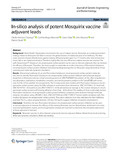| dc.description.abstract | Background
World Health Organization recommend the use of malaria vaccine, Mosquirix, as a malaria prevention strategy. However, Mosquirix has failed to reduce the global burden of malaria because of its inefficacy. The Mosquirix vaccine’s modest effectiveness against malaria, 36% among kids aged 5 to 17 months who need at least four doses, fails to aid malaria eradication. Therefore, highly effective and efficacious malaria vaccines are required. The well-characterized P. falciparum circumsporozoite surface protein can be used to discover adjuvants that can increase the efficacy of Mosquirix. Therefore, the study sought to undertake an in-silico discovery of Plasmodium falciparum circumsporozoite surface protein inhibitors with pharmacological properties on Mosquirix using hierarchical virtual screening and molecular dynamics simulation.
Results
Monoclonal antibody L9, an anti-Plasmodium falciparum circumsporozoite surface protein molecule, was used to identify Plasmodium falciparum circumsporozoite surface protein inhibitors with pharmacological properties on Mosquirix during a virtual screening process in ZINCPHARMER that yielded 23 hits. After drug-likeness and absorption, distribution, metabolism, excretion, and toxicity property analysis in the SwissADME web server, only 9 of the 23 hits satisfied the requirements. The 9 compounds were docked with Plasmodium falciparum circumsporozoite surface protein using the PyRx software to understand their interactions. ZINC25374360 (−8.1 kcal/mol), ZINC40144754 (−8.3 kcal/mol), and ZINC71996727 (−8.9 kcal/mol) bound strongly to Plasmodium falciparum circumsporozoite surface protein with binding affinities of less than −8.0 kcal/mol. The stability of these molecularly docked Plasmodium falciparum circumsporozoite surface protein-inhibitor complexes were assessed through molecular dynamics simulation using GROMACS 2022. ZINC25374360 and ZINC71996727 formed stable complexes with Plasmodium falciparum circumsporozoite surface protein. They were subjected to in vitro validation for their inhibitory potential. The IC50 values ranging between 250 and 350 ng/ml suggest inhibition of parasite development.
Conclusion
Therefore, the two Plasmodium falciparum circumsporozoite surface protein inhibitors can be used as vaccine adjuvants to increase the efficacy of the existing Mosquirix vaccine. Nevertheless, additional in vivo tests, structural optimization studies, and homogenization analysis are essential to determine the anti-plasmodial action of these adjuvants in humans. | en_US |

